Heading out the door? Read this article on the new Outside+ app available now on iOS devices for members! Download the app.
I like rules and structure. They make me feel safe.
I grew up with a lot of uncertainty in a family that was devastated by addiction. I was highly sensitive to everyone around me, and my ability to tolerate change has always been quite low.
As a result, I controlled everything I could. As a little girl, it came out in the precise manner in which I organized my books and dolls. As I grew older, it was how I fixated on the food that I did—or did not—eat.
Even the manner in which I moved my body was built around rules. I was attracted to disciplines (that word still excites me) that were built entirely around a certain way of doing something, such as ballet and Mysore Ashtanga, which teaches a set sequence of poses practiced in the same prescribed manner each class.
My life was extremely regimented. And small. If something or someone didn’t fit, I refused to expand to accommodate it or them. For a very long time, my need to stay within the lines blocked out any possibility for anything outside of what I knew, including joy.
Then I met my husband. Instead of cutting our first date short so I could wake up at 5 a.m. and shove my legs behind my head like I did every other day, I decided to color outside the lines a bit. I stayed up talking with him all night and agreed to breakfast the next morning. For the first time in the nearly 15 years that I had practiced yoga, I skipped my morning practice. It felt blasphemous. I was terrified of what would happen. But you know what happened? Nothing. And everything.
Cut to six years later. We have a son (and another on the way), a dog, and a house. I can honestly say that as much as I miss the depth that I went to in my yoga practice, I would much rather have this expansive and full and uncontrollable life that is so much more beautiful than the outline of what I thought I had wanted and that I had been trying to stuff myself into for so long.
Finding freedom in letting go
Practicing yoga in a less-rigid way actually helped with my change in perspective. The first time SmartFlow founder Annie Carpenter, a Martha Graham-trained dancer and a yoga teacher, invited us to “willow” in Trikonasana (Triangle Pose), I felt like my world exploded open. I experienced an expansion I had never felt in my Mysore practice. It was the freedom of moving beyond the confines of what I had always done.
Carpenter broke the rules simply by side-bending. It’s so simple yet so profound. And it reinforced what I was learning outside of the studio, which is sometimes you need to think outside of the lines to make art.
Side-bending continues to exemplify this for me. Each time I add lateral flexion to a pose that doesn’t classically include it, I find an expansiveness that is only possible when I bend a few rules.
See also: How Yoga Transforms Lives
A sequence to help you bend the rules
Remember, art is subjective, and you are your own masterpiece. Try to keep in mind that just because we are leading up to Vasisthasana (Side Plank Pose) doesn’t mean it’s the only focus. Bring to each pose a sense of wonder and inquiry to help you find aspects of yourself and possibilities that you might not have known existed.
Side bends and any side movements take place in the coronal plane of your body, so I like to sing “My Coronal” to the tune of “My Sharona” by The Ramones while I play with side bends.
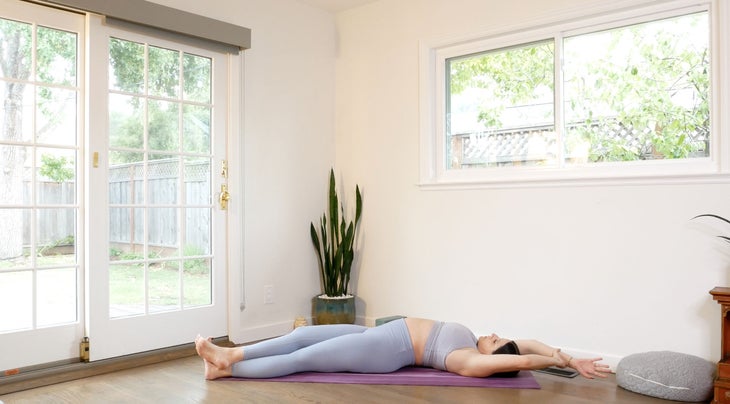
Supine Mountain Pose Stretch
Lie on your back and separate your feet as wide as the mat. On an inhale, reach both arms overhead in line with your ears. Cross your right ankle over your left and as you exhale, begin to reach your hands and legs toward the left. (You might feel like a banana.) Try not to arch your back. Instead, keep your front ribs releasing down toward your hips so that the movement can truly be through your side body. Remain here for 5 breaths. Uncross your legs and inhale your way back through center. Cross your opposite ankle and repeat on the other side.
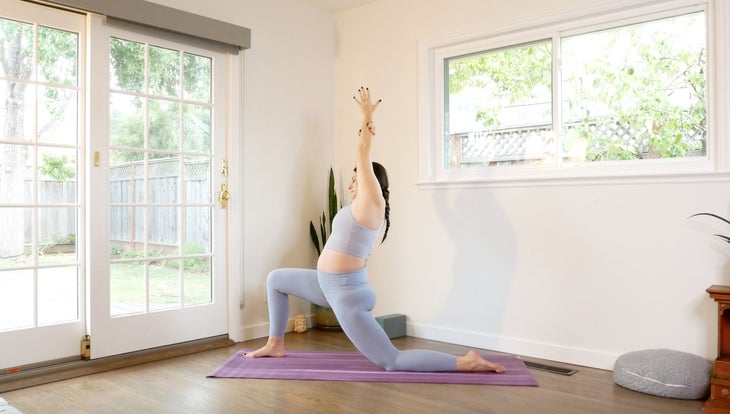
Low Lunge Side Stretch
Come to Tabletop. Step your right foot between your hands and lift yourself upright with your arms alongside your ears to Anjaneyasana (Low Lunge). Grab your left forearm with your right hand and, on an exhale, lean to your right. (Some teachers suggest you grab your wrist, but I have found that holding the forearm helps you initiate the side bend stretch from your pelvis rather than your arms.) You can look straight ahead or turn your gaze up under your top arm. Remain here for 5 breaths. On an inhale, return through center and release your grasp. Exhale and bring your hands to the floor and come back to Tabletop. Repeat on your other side.
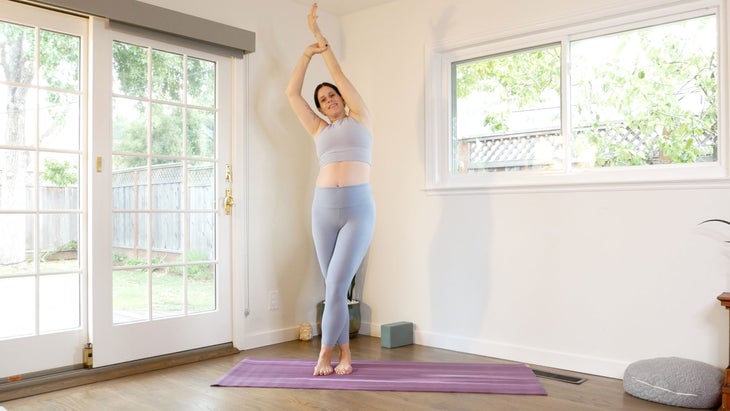
Standing Mountain Pose Stretch
This is similar to the pose you did on the floor but now standing, which can feel a little wild. Because there is no floor supporting your back, you need to rely on proprioception and alignment memory.
Begin in Tadasana (Mountain Pose) at the top of your mat with your feet hip-width apart. Inhale your arms upward. Cross your right ankle in front of your left, keeping both legs straight. Grab your right forearm with your left hand. Inhale and, as you exhale, side bend toward your left. Resist the tendency to twist by keeping your chest facing forward. Remain here for 5 breaths. Repeat on your other side.

Tree Pose Side Bend
I love this pose. I say that about all poses, but this is definitely my favorite side-bending pose! Usually in Vrksasana (Tree Pose), we emphasize firming the standing leg hip to find evenness in the pelvis. Allowing the side-bend to take place might feel as if you’re going against everything you have been taught, but if you continue to observe your breath and focus on equal length in the spine, you might find a whole new environment for your practice to thrive.
You can stand alongside a wall and use it for balance if necessary. Stand at the top of your mat and bring your right heel somewhere on your left leg, whether it’s at your ankle, your calf, or your inner thigh (but not your knee, of course). Inhale your arms up and in line with your ears. Bring your knee out toward the right. On an exhale, side bend toward your bent right knee. If you can, rest your right elbow on your top right thigh and reach your left arm overhead. Remain here for 5 breaths. Inhale yourself back upright to Tree Pose. Exhale and release your right foot to the floor. Repeat on your other side.

Half Moon Pose With a Side Stretch
Wait, this might be my favorite side-bend! Ardha Chandrasana (Half Moon Pose) is another shape that traditionally emphasizes stacking your hips. Allowing your body to “willow,” as Annie Carpenter instructs, not only expands the ribs on the top side waist, but it allows you to explore your balance in an unconfined manner. It demonstrates to you that balance is not a fixed point but any point along a spectrum. The more comfortable you can get at any point, the more inner balance you can find.
Face the long side of your mat and step your feet wide apart. Turn your right foot toward the front of the mat and turn your back foot and hip slightly inward. Inhale your arms wide and on an exhale, tip into Trikonasana (Triangle Pose) to begin, with your bottom hand on a block and your top arm reaching skyward. Walk your bottom hand or block forward and inhale your left leg to hip height to come into Half Moon Pose.
Then reach your top arm overhead alongside your ear. In your own time, bend your bottom elbow and tip your pelvis further forward over your front leg until your top leg is higher than your torso. Your top hand might reach the floor in front of your toes, and if it does, rest on your fingertips. Hold the posture for a few breaths. On an inhale, straighten your bottom arm and lift your top arm back up to the ceiling to come back into Half Moon Pose. On an exhale, carefully step back to Triangle Pose and then lift your torso upright. Repeat on your other side.
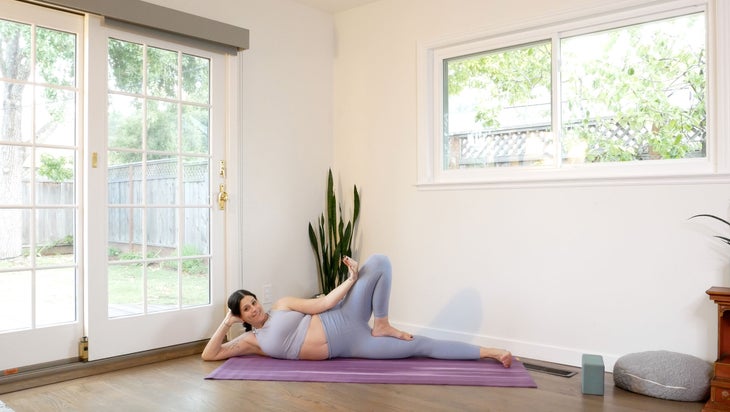
Anantasana (Reclining Pose Dedicated to Vishnu)
This under-taught shape is one of the few postures that is side-focused, but even in this pose, it is classically taught with an emphasis on having even length on both sides. It is named after Vishnu’s loyal servant, the serpent Ananta, upon whom he is said to rest while floating around the cosmos. This posture is meant to represent a balance of repose and reverence, and reminds us that we can show up fully and still have joy.
Come onto the floor, roll onto your right side, and bend your right elbow to support your ear in your palm. Try to balance on your outer hip and thigh. Bend your left leg and set it up into Vrksasana (Tree Pose). Your left elbow can be bent resting on your side or you can place it in front of you like a kickstand for balance. Remain here for 5 breaths. On an exhale, bring your legs back together. Roll onto your tummy and over onto your other side and repeat.

Side Plank With Side Bend
This is a good place to remind you that there really is not one way to do a pose. Though you’ll hear people refer to the “traditional” alignment of poses, when you look across the different schools of yoga, you’ll see that means different things. Side Plank is one of those poses. Some teachers emphasize keeping a long spine and being on the razor’s edge of your feet, almost like Mountain Pose on your side. Others instruct you to get your feet flat and arc your side body.
Come to Plank Pose. Bring your feet together and roll onto the outer edge of your right foot. Inhale your left arm overhead and alongside your ear. Press your bottom hand down into the mat and lift your side hips toward the sky. Your feet will be reaching toward the floor. Remain here for a few breaths. Inhale and reach your left arm up toward the ceiling. Come back to Plank Pose and repeat on your second side.
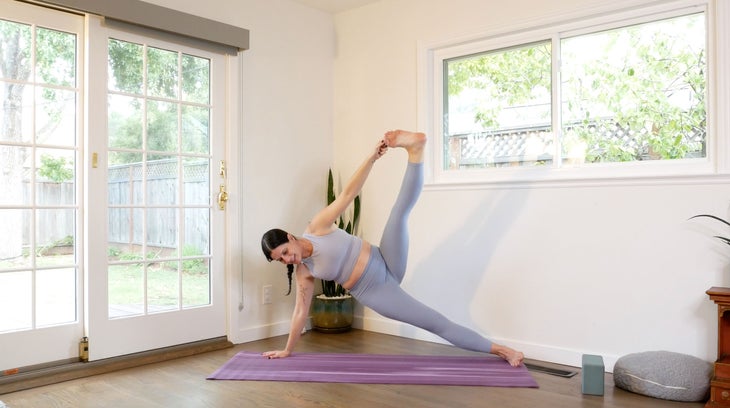
Side Plank Pose With Big Toe Hold
Come into Side Plank Pose as you did above but keep an even spine on both sides. Turn your left leg out to the side (externally rotate) and, on an inhale, begin to lift it up toward the ceiling. Roll your top hip slightly forward to broaden through your lower back. Try to catch your left big toe with your first two fingers (or use a strap around your foot and hold that). Breathe. If your neck allows, look up to your top arm. On an exhale, release the clasp and slowly lower your lifted leg back to Side Plank. Pass through Plank Pose or maybe do an Adho Mukha Svanasana (Downward-Facing Dog) before repeating on your other side.
Cool-down stretches
Some of the main muscles we engage during side-bending include your quadratus lumborum and obliques. After a focused side-bending practice, it can be nice to lengthen those muscle groups with poses including Parvritta Janu Sirsasana (Revolved Head-to-Knee Pose) or Sukhasana (Easy Pose) with a bend to each side.
See also: 5 Calming Yoga Poses You Can Do In 5 Minutes
About our contributor
Sarah Ezrin is an author, world-renowned yoga educator, popular Instagram influencer, and mama based in the San Francisco Bay Area. Her willingness to be unabashedly honest and vulnerable along with her innate wisdom make her writing, yoga classes, and social media great sources of healing and inner peace for many people. Sarah is changing the world, teaching self-love one person at a time. You can follow her on Instagram at @sarahezrinyoga and TikTok at @sarahezrin.